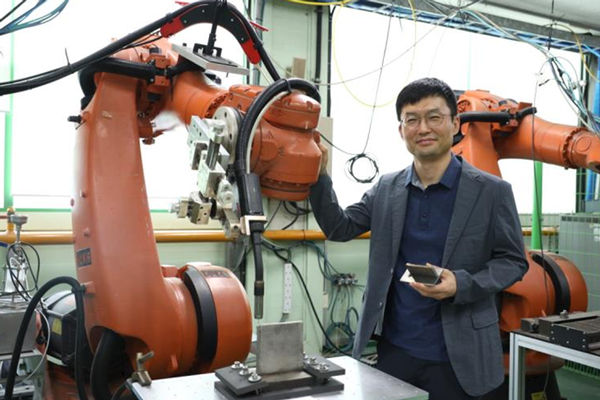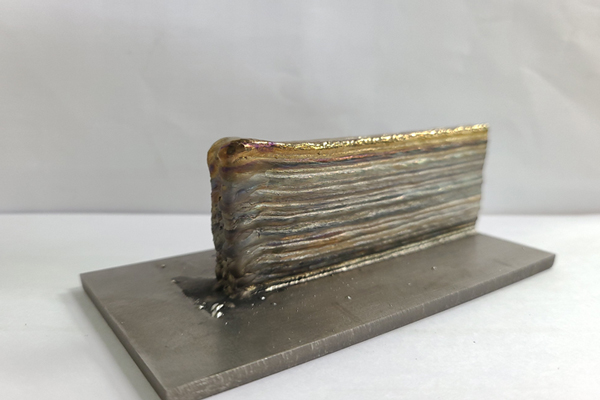생기원, 아크와 와이어 활용해 '티타늄 3D프린팅' 개선
기사입력 2021.09.10 10:50
생기원, 고품질 티타늄 부품 고속생산 위한
아크와 와이어 활용 금속 3D프린팅 기술 개발
분말 소재보다 5배 빠르게 대형 부품도 제작 가능
한국생산기술연구원은 8일, 전기 불꽃인 아크(Arc)와 와이어(Wire)를 활용한 금속 3D프린팅 기술을 개발하고, 티타늄 소재 공정 최적화를 달성했다고 밝혔다.

▲ 아크 열원과 와이어를 활용한 금속 3D프린팅
기술을 개발한 감동혁 박사 [사진=생기원]
기술을 개발한 감동혁 박사 [사진=생기원]
티타늄은 강철만큼 강하지만 무게는 그 절반 수준으로 가볍고 녹슬지 않으며 열을 잘 견디는 특성이 있어 항공우주, 에너지, 플랜트, 국방산업의 차세대 부품소재로 주목받고 있다. 하지만 대표적인 난삭(難削) 소재로 손꼽힐 만큼 단단해 가공이 어렵고, 고온에서 산화되기 때문에 용접도 곤란하다는 단점이 있다.
대안으로 금속 3D프린팅을 활용한 가공방식이 있지만, 분말 소재와 열원에 비용이 많이 들고, 시간당 900g 정도밖에 적층하지 못해 생산성이 떨어졌다. 생기원 접합적층연구부문 감동혁 박사 연구팀은 기존 레이저 대신 아크를 열원으로 사용하고 분말 소재를 와이어로 대체한 금속 3D프린팅 기술을 개발했다.
이 기술에 사용되는 아크 열원은 레이저 장비 가격의 1/10 수준이라 구축 비용이 매우 저렴하고 대형부품 제작에도 유리하다는 장점이 있다. 또한 분말 대신 와이어를 녹여 적층하기 때문에 소재 가격이 80%가량 저렴하고, 재료의 낭비도 65% 줄일 수 있을 뿐만 아니라 적층 속도까지 5배가량 향상된다.
그런데 이 기술은 일반 금속 소재를 적층할 때 직류를 전원으로 쓰고 소재를 열원과 다른 각도에서 쌓는 방식을 활용하는데, 티타늄은 적층 품질 저하와 시스템 자동화에 어려움이 있었다. 티타늄에는 열전자를 방출하는 고유의 특성이 있어 와이어를 녹일 때 직류를 사용하면 불안정한 플라스마가 발생하기 때문이다.
이 경우 열이 제대로 전달되지 않아 소재가 주변으로 튀거나 불균일하게 쌓이면서 거품들이 생겨 불량으로 이어지게 된다. 연구팀은 시간이 흐름에 따라 크기와 방향이 주기적으로 변하는 교류 전원 기반의 단락 이행 기술과 헬륨가스 환경 조성 공정을 독자 개발해 티타늄 부품 공정문제도 해결해냈다.

▲ 개발한 기술로 쌓아올린 티타늄 적층물 [사진=생기원]
교류 전원 기반 단락 이행 기술을 활용하면, 아크의 극성을 바꾸면서 전압은 낮추고 전류는 감소시킬 수 있다. 이때 열원과 와이어를 같은 축에 두고 소재를 녹이면, 튀는 현상 없이 깨끗하고 균일하게 쌓는 것이 가능하다. 또한, 헬륨가스 환경을 조성하여 티타늄의 산화를 방지하는 가공방식도 개발했다.
연구팀은 복잡한 모양의 제품을 정밀하게 제작하기 어렵다는 아크 와이어 적층 방식의 단점을 극복하기 위해 적층과 후가공, 진단을 통합한 복합시스템도 개발 중이다. 적층 모니터링 및 AI 품질 예측 기술이 포함돼 온도, 형상 등의 공정변수를 실시간 제어가 가능하고, 복잡한 형상도 고품질로 생산할 수 있을 전망이다.
감동혁 박사는 “이번 기술은 금속 3D프린팅 시스템의 고속화, 고품질화, 대면적화를 구현한다”라며, “티타늄 수요가 많은 국방 부품 경량화를 시작으로 에너지와 화학 플랜트로 분야를 넓혀 향후 항공우주 산업까지 확대할 계획”이라고 밝혔다.
이수민 기자
타이타늄 분말 기술 활용 및 고순도 탄탈륨 분말 제조 기술
2021-06-08 10:30~12:00
e4ds / 박지환 대표이사
많이 본 뉴스
[열린보도원칙] 당 매체는 독자와 취재원 등 뉴스이용자의 권리 보장을 위해 반론이나 정정보도, 추후보도를 요청할 수 있는 창구를 열어두고 있음을 알려드립니다.
고충처리인 장은성 070-4699-5321 , news@e4ds.com

.jpg)
.jpg)
.jpg)





